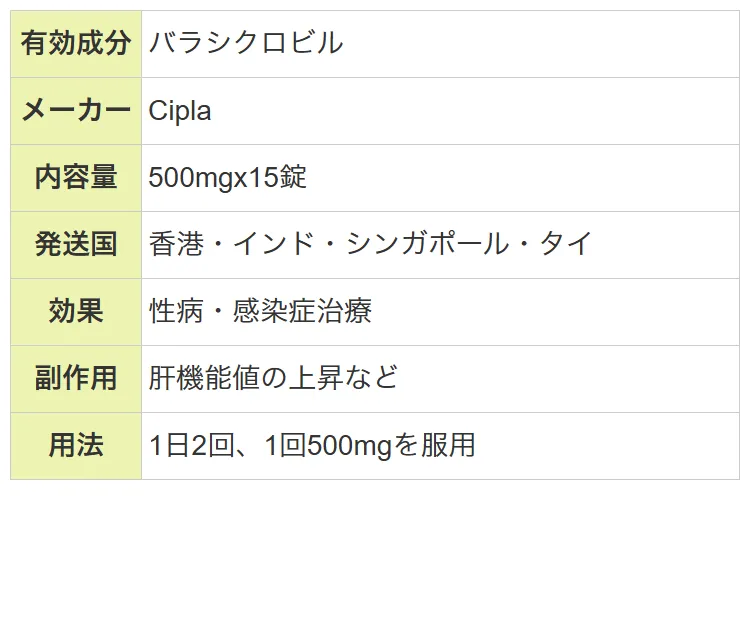ヘルペス持ちなのでお守りとして持ってます効果の程は分かりませんが安心材料にはなります

左記クレジットカード、銀行振込、コンビニ決済に対応



更新日:2025/4/30

| 個数 | 販売価格(1錠あたり) | 販売価格(箱) | ポイント | 購入 |
|---|---|---|---|---|
| 6錠 | 626円 | 3,760円 | 112pt | 売り切れ |
| 12錠 | 446円 | 5,360円 | 160pt | 売り切れ |
| 24錠 | 298円 | 7,160円 | 214pt | 売り切れ |






①1万円以上で送料無料
1回の注文で10,000円以上だった場合、1,000円の送料が無料となります。
まとめ買いをすると1商品あたりのコストパフォーマンスが高くなるためおすすめです。
②プライバシー守る安心梱包
外箱に当サイト名や商品名が記載されることはないため、ご家族や配達員など第三者に内容を知られることは御座いません。

③100%メーカー正規品取り扱い
当サイトの商品は100%メーカー正規品となっており、第三者機関による鑑定も行っております。
商品の破損などがあった場合は再配送などにて対応させて頂きますので、ご連絡頂ければ幸いです。

④いつでも購入可能 処方箋不要
サイト上では24時間いつでもご注文を受けております。
また、お電話によるご注文も受け付けておりますのでネットが苦手な方はお気軽にどうぞ。

⑤商品到着100%
商品発送後はお荷物の追跡状況が分かる追跡番号をご案内させて頂きます。
郵便局には保管期限がありますのでご注意ください。
・自宅配達で不在だった場合の保管期限・・・16日間前後
・郵便局留めとした場合の保管期限・・・7~30日間

⑥コンビニ決済利用可能
ご近所のコンビニにていつでもお支払可能です。
セブンイレブンに限り店舗での機械操作を必要とせず、手続き完了後に表示されるバーコードや払込票番号をレジに提示することでお支払い頂けます。

バルシビル 1000mg x 24錠
7,160円
ポイント:214pt
10,000円以上購入で送料無料
売り切れ

ヘルペス持ちなのでお守りとして持ってます効果の程は分かりませんが安心材料にはなります
服用後、薬が体に効いてくると同時に眠気がきて、日によっては吐き気も現れます。心配するほど強い症状ではありませんが、できるだけ飲まないほうが良さそう・・・
個人差はありますが2週間ほどで自然と症状がおさまります。しかし、薬を使えば症状は軽くなりますし治癒までの期間も短くなります。
吐き気や下痢、眠気、めまい、頭痛などがありますが、過度に飲まない限り重症化するようなことはほとんどありません。しかし、呼吸困難などアナフィラキシーショックの兆候が見られた際はすぐに服用を停止し、医師の診断を受けてください。
症状の原因がはっきりしていない場合は使用を避けて、検査や医師の診断を受けることを推奨いたします。できものの原因がヘルペスだと判明した場合は使用しても問題ありません。
バルトレックスやゾビラックスは副作用が少ないと言われています。しかし、副作用の現れ方や強さには個人差がありますのでご注意ください。
お薬によります。注意が必要なものはシメチジンやモフェチル、テオフィリン、プロベネシドです。これらのお薬を服用されている方はヘルペス薬を服用する前に医師へ併用に問題はないかなどを確認することを推奨いたします。
完全に抑えることは非常に難しいです。体内のヘルペスウイルスを完全に死滅させることは現代医学でも不可能とされており、体調不良や過度のストレスなどにより免疫力が下がってしまうとヘルペスウイルスが活発化し再発してしまいます。そのため、再発を抑えるためには免疫力を高め健康な状態を維持することが重要です。そして、再発の予兆を感じた際は早めに病院に行く、またはお薬を飲むことことが症状軽減対策になります。
| 1日の服用回数 | 1回 |
|---|---|
| 1回の服用量 | 500~1000mg |
| 服用のタイミング | 朝晩 |
| 服用期間 | 12時間 |
| 1日の服用回数 | 1回 |
|---|---|
| 1回の服用量 | 1000mg |
| 服用のタイミング | 朝昼晩 |
| 服用期間 | 6時間 |
| 1日の服用回数 | 1回 |
|---|---|
| 1回の服用量 | 1000mg |
| 服用のタイミング | 朝昼晩 |
| 服用期間 | 6時間 |
| 1日の服用回数 | 1~2回 |
|---|---|
| 1回の服用量 | 500mg |
| 服用のタイミング | 指定なし |
| 服用期間 | 24時間 |
| 商品名 | ジミビル | アシビルDT | ゾビラックス | ゾビラックスクリーム | バルクロビル | ゼリトレックス | アシビル眼軟膏 |
|---|---|---|---|---|---|---|---|
| 商品画像 |  |  |  |  |  |  |  |
| 特徴1 | ・ヘルペスウイルスの増殖を抑制 | ・インドで有名なシプラ社が販売 | ・有効成分の含有量が3種類 | ・単純疱疹や帯状疱疹を改善 | ・体内で変換されて抗ウイルス効果を発揮 | ・バルトレックス錠と並ぶほどの優れた効果がある | ・ジェネリックだから治療費の負担を抑えられる |
| 特徴2 | ・単純疱疹や帯状疱疹を改善 | ・飲塗り薬よりも効き目が強い | ・外用タイプのヘルペス治療薬アシビルクリームもある | ・ヘルペスウイルスの増殖を抑制 | ・吸収効率がいい第2世代の抗ウイルス薬 | ・ヘルペスウイルスによる症状を効果的に改善する | ・国内でも処方されている薬のジェネリックだから安全 |
| 内容量 | 500mg21錠x1箱 | 200mgx100錠 | 200mgx25錠 | 5% 2gx1本 | 500mgx20錠 | 500mg42錠x1箱 | 3%5gx1本 |
| 価格 | 8,160円 | 7,160円 | 4,060円 | 4,260円 | 5,960円 | 8,460円 | 3,660円 |
本製品は海外製のため、期限表記が日本と異なる場合がございます。
パッケージ裏面や側面、シートなどに以下のような表記がされています。
| EXP | 使用期限 例:EXP 12/2025→2025年12月まで使用可 |
|---|---|
| MFG または MFD | 製造日 例:MFG 03/2023 |
| BEST BEFORE | 品質が最も安定している目安日 |


※国や製品により日付の並び(例:月/年、日/月/年)が異なる場合がありますのでご注意ください
EXP(Expiry Date) の表記がなく、MFG または MFDしか記載がないケースがあります。
この場合は MFG(MFD) から2~3年が使用期限の目安です。
※「LOT」や「BATCH」の表記は製造番号であり期限ではありません。

パッケージ例となります。
商品やご注文単位によってはシート単位でのお届けとなる場合が御座います。
外箱に当サイト名や商品名が記載されることはないため、ご家族や配達員など第三者に内容を知られることは御座いません。
ヘルペス持ちなのでお守りとして持ってます効果の程は分かりませんが安心材料にはなります
毎回お世話になってますがヘルペス初めてなってしまって困りましたがとても効果ありました。また買おうと思います。
この薬だけは必ずどこに行くときでも持ち歩くようにしています。外出先でも再発しそうになることがあるんですけど、持ち歩いておけば対処も早いから悪化しません。友達も最近ヘルペスになったと言ってたのでバルシビルを勧めてあげたら凄く喜んでました。ヘルペス持ちにはオススメの治療薬です◎
日本の病院でもらう薬と遜色ありません。飲めばすぐに効果が出てくるので痛痒さで悩むことが少なくなります。今はできそうなときからすでに服用するようにしてるので、ここ1年位ヘルペス発生してません。
服用後、薬が体に効いてくると同時に眠気がきて、日によっては吐き気も現れます。心配するほど強い症状ではありませんが、できるだけ飲まないほうが良さそう・・・
商品口コミの投稿は会員のみ行えるようになっております。
お手数ですが会員ログインの上でご投稿頂きますようお願いいたします。
口コミをご投稿頂いたお客様にはポイントをプレゼントさせて頂いております。
文章のみであれば100ポイント、文章+写真付きのものは300ポイントをプレゼントさせて頂きます。
規約や詳細などはこちらをご確認くださいませ。